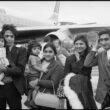
Editors: Richard Allen, Ira Bhaskar
Publ: Intellect, Bristol, UK/Chicago, USA
Bombay’s Islamicate Histories, its editors Richard Allen and Ira Bhaskar say in the introduction, has been developed as ‘a reader’ that will be of value to students of cinema who wish to understand the way in which Islamicate idioms inform Bombay cinema. I would add that it does a lot more.
In the span of 14 essays by major scholars, this collection develops an understanding of how Islamicate culture – with its multiple historical influences – have shaped and continue to influence complex social and cultural integrations, and indeed identities, in India.
By reflecting on how Bombay cinema, and the Bollywood film industry, have interacted with and absorbed Islamicate culture, and how they have each interwoven these influences into India’s social consciousness and public discourse, this book counters the political assertions that seek to erase the influence of Islamic culture and establish Hindu-ness as a dominant identity in a country where multiplicity and syncretism ‘make India what it is’.
Explaining ‘Islamicate’
To begin, the word ‘Islamicate’ needs some unpacking. Even though it was first coined by Marshall Hodgson in 1958 to refer to ‘the aesthetic and cultural forms “historically associated with Islam and the Muslims, both among Muslims themselves and even when found among non-Muslims”’, it has not become readily acceptable in social discourse.
The premise of the word is to distinguish culture from religion, and while Islamicate is an umbrella term that encompasses the variety of different cultural traditions that issue from the Islamic world, it also allows a way of characterizing cross-cultural interactions within and beyond the Islamic world – such as in Indian society where Islamicate forms circulate independently of their religious context.
The editors, Allen and Bhaskar, acknowledge that there are various objections to the term Islamicate. One objection is that it separates considerations of culture from considerations of religion; they counter that the intention is not to exclude religion but to emphasize how social and cultural practices within Islamdom are not simply (or only) religious in nature, and that they may have a role that cannot be reduced to religious explanation.
They discuss some of the other objections but, ultimately, they rightfully conclude that they do not necessitate abandoning the term but rather encourage analyzing and negotiating its complexities. They also add that the need to do this is even more important now, in today’s political clime, since it allows for an exploration of the significance of Islamicate traditions for their constitutive role in popular culture in India.
Islamicate cultures and idioms
The collection is structured into two-parts that unpack the term Islamicate through an exploration of Islamic culture’s influence on Bombay cinema and Bollywood film.
Part One – Islamicate Histories – explores historical moments, linguistic influences, and political ideologies that have shaped the texture of Bombay cinema. The first essay begins by tracing the history of the Parsi influence on the development of Bombay cinema, the theatricality of Urdu, and how it has shaped performance art.
Two of the essays discuss the influence of the Mughal empire on Bombay cinema: one looks at the interplay between representations of courtly life in Mughal art and in textual narratives, and the interpretations that one can draw from the gaps between them, while the other zeroes in on a legendary Mughal couple – Emperor Jahangir and Empress Nur Jahan – and examines how their depiction in literary texts and visual material illustrates the concepts of Mughal justice and love.
The final essay in Part One focuses on a controversial Bollywood film Padmaavat as a reference point to understanding the cultural portrayal of Muslims in contemporary India, and emerging symbols of patriotism. It works as a perfect bridge into part two of the book – Cinematic Forms – which explores how Islamicate cultures have had a constitutive role in developing the genres, aesthetic forms, and ideologies of Bombay cinema.
Part Two of the book starts with a discussion of how three versions of Ali Baba and the Forty Thieves, with their inflections of Islamicate culture, have left traces on Indian cinema history. Part Two also ends with a discussion of three films, except that their subject matter is terrorism and this essay considers how they further fracture Hindu-Muslim relations by translating a complex situation into a desire to control a city and its Muslims. Other chapters in Part Two look at the evolution of the ghazal from a poetic recitation in performance spaces to a film song, while one essay examines how a film that celebrates North Indian Kathak dance illustrates the post-Partition tension between Hindu and Urdu culture. A controversial Bollywood actor – Salman Khan – also merits a full essay in this collection in which his appeal among underprivileged working-class Muslims is discussed.
Contemplative moments
One of the essays that triggered a personal reflection was Peter Knapczyk’s exploration of the connection between mourning, femininity, and language as depicted in Sufi romance and Shia elegy. His analysis of the mars̤iya as a poetic expression, with elements of the virahiṇī trope, and how it gives a prominent voice to the women of Imām Husain’s family who are the only survivors left to mourn the martyrs of Karbala (essay 3) prompted me to think about a prevalent practice in my own Shia community.
I was also intrigued by Richard Allen’s discussion of the institution of pardā, its incorporation into narratives of mistaken identity, and its creation of a space to express desire and render women visible. The idea that resonated with me most deeply here was how the visual and physical concealment of the pardā bestows a special power upon the voice, which can overcome physical separation.
The analysis in various chapters of the formative role that language plays in culture also gave me pause. For instance, in discussing the romanticized and decadent figure of the tawāʼif as a singer and dancer and their erased history as poets and writers in popular Urdu print culture, Shweta Sachdeva Jha mentions the Arabic origin of the word tawāʼif and how its gradual adoption in casual usage has denigrated the high-culture origin of the art form into representing a courtesan or prostitute.
Similarly, in Ira Bhaskar’s essay on how the qawwali has gained acceptance among non-Muslim populations and informed contemporary Bollywood film music, his one statement about the ‘slipperiness’ of the Hindi/ Urdu distinction and how it raises the question of ‘whether, when and under what circumstances these are really two languages at all’ captures the theme of the entire collection.
Overall, this collection shows how Islamicate cultural forms have been absorbed so fully into Bombay cinema and Bollywood film that it is no longer apparent where certain influences have come from. Each essay unweaves a piece of the complicated tapestry that is Indian society today and it makes a strong and powerful statement: that the history of Islam in India cannot be erased or seen as antithetical to the core identity of the nation without destroying the nation itself.






